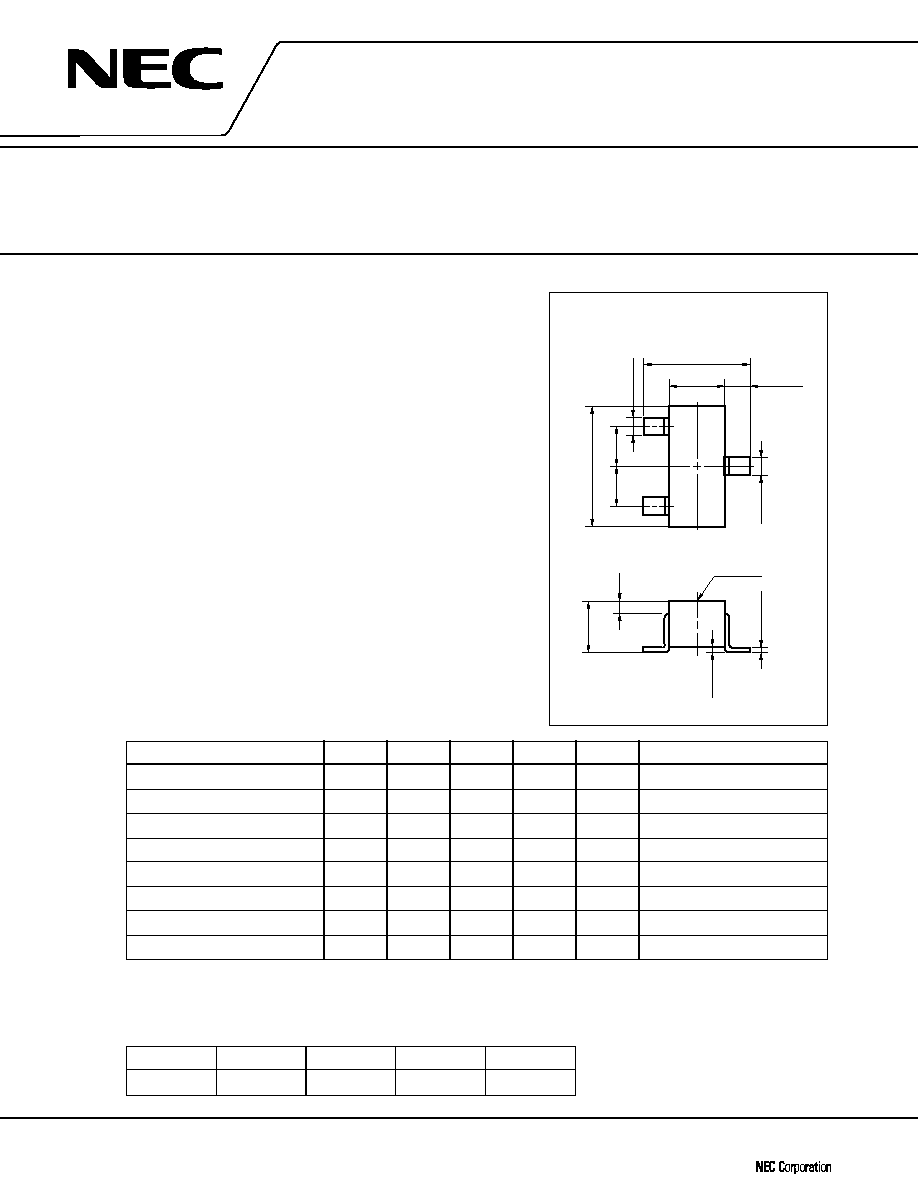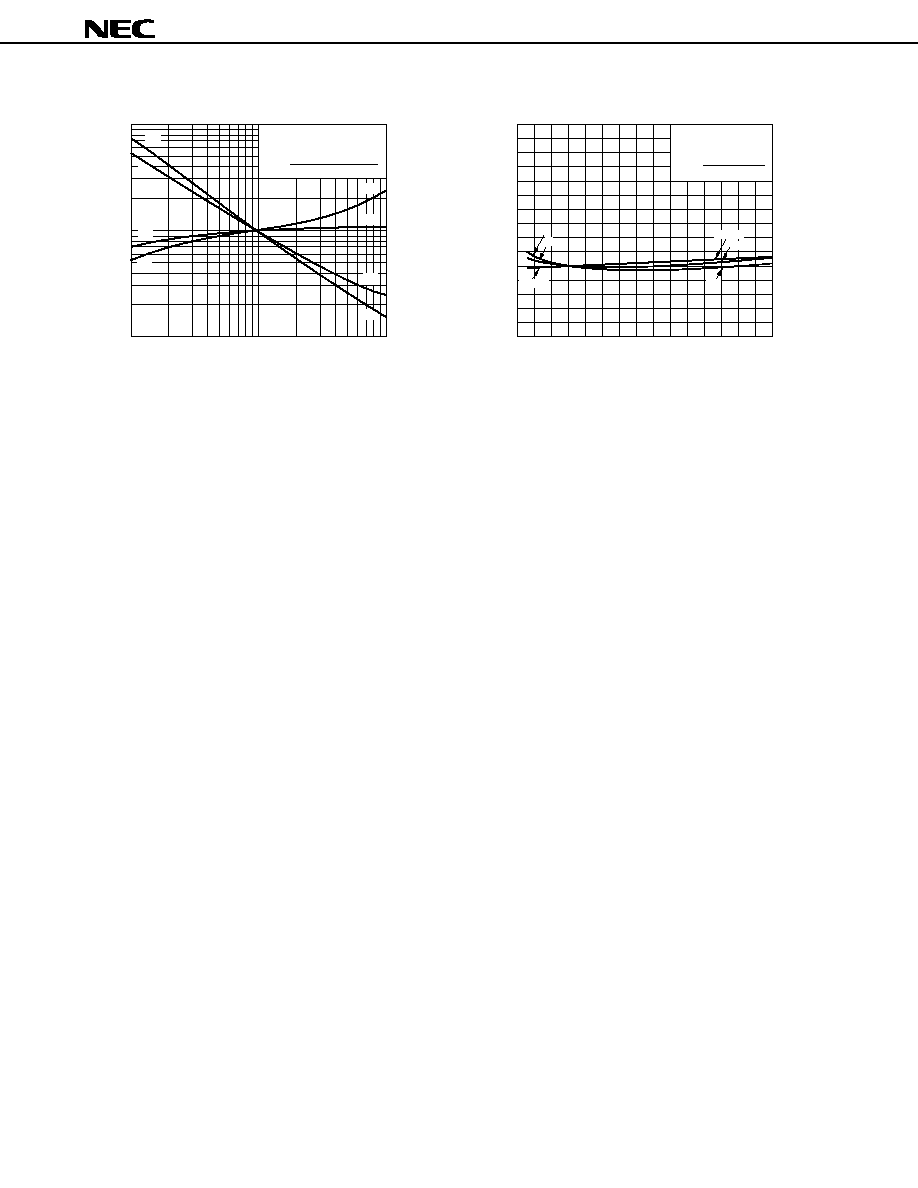 | –≠–ª–µ–∫—Ç—Ä–æ–Ω–Ω—ã–π –∫–æ–º–ø–æ–Ω–µ–Ω—Ç: 2SC1623 | –°–∫–∞—á–∞—Ç—å:  PDF PDF  ZIP ZIP |

SILICON TRANSISTOR
2SC1623
FEATURES
∑
High DC Current Gain: h
FE
= 200 TYP.
(V
CE
= 6.0 V, I
C
= 1.0 mA)
∑
High Voltage: V
CEO
= 50 V
ABSOLUTE MAXIMUM RATINGS
Maximum Voltages and Current (TA = 25 ∞C)
Collector to Base Voltage
V
CBO
60
V
Collector to Emitter Voltage
V
CEO
50
V
Emitter to Base Voltage
V
EBO
5.0
V
Collector Current (DC)
I
C
100
mA
Maximum Power Dissipation
Total Power Dissipation
at 25 ∞C Ambient Temperature P
T
200
mW
Maximum Temperatures
Junction Temperature
T
j
150
∞C
Storage Temperature Range
T
stg
≠55 to +150
∞C
AUDIO FREQUENCY GENERAL PURPOSE AMPLIFIER
NPN SILICON EPITAXIAL TRANSISTOR
MINI MOLD
PACKAGE DIMENSIONS
in millimeters
©
1984
DATA SHEET
1.5
2.8 ± 0.2
0.65
+0.1
≠0.15
0.4
+0.1 ≠
0.05
2
1
3
0.4
+0.1 ≠
0.05
0.95
0.95
2.9 ± 0.2
0.3
1.1 to 1.4
0 to 0.1
0.16
+0.1 ≠
0.06
Marking
1: Emitter
2: Base
3: Collector
Document No. TC-1481C
(O.D. No. TC-5172C)
Date Published July 1995 P
Printed in Japan
ELECTRICAL CHARACTERISTICS (T
A
= 25 ∞C)
CHARACTERISTIC
SYMBOL
MIN.
TYP.
MAX.
UNIT
TEST CONDITIONS
Collector Cutoff Current
I
CBO
0.1
µ
A
V
CB
= 60 V, I
E
= 0
Emitter Cutoff Current
I
EBO
0.1
µ
A
V
EB
= 5.0 V, I
C
= 0
DC Current Gain
h
FE
90
200
600
V
CE
= 6.0 V, I
C
= 1.0 mA*
Collector Saturation Voltage
V
CE(sat)
0.15
0.3
V
I
C
= 100 mA, I
B
= 10 mA*
Base to Saturation Voltage
V
BE(sat)
0.86
1.0
V
I
C
= 100 mA, I
B
= 10 mA*
Base Emitter Voltage
V
BE
0.55
0.62
0.65
V
V
CE
= 6.0 V, I
C
= 1.0 mA*
Gain Bandwidth Product
f
T
250
MHz
V
CE
= 6.0 V, I
E
= ≠10 mA
Output Capacitance
C
ob
3.0
pF
V
CB
= 6.0 V, I
E
= 0, f = 1.0 MHz
* Pulsed: PW
350
µ
s, Duty Cycle
2 %
h
FE
Classification
Marking
L4
L5
L6
L7
h
FE
90 to 180
135 to 270
200 to 400
300 to 600

2SC1623
2
TYPICAL CHARACTERISTICS (T
A
= 25 ∞C)
Free air
200
180
160
140
120
100
80
60
40
20
0
≠20 0
20
40
60
80 100 120 140 160 180
T
A
- Ambient Temperature - ∞C
P
T
- Total Power Dissipation - mW
TOTAL POWER DISSIPATION vs.
AMBIENT TEMPERATURE
10000
5000
2000
1000
500
200
100
50
20
10
5
2
1
0
20
40
60
80
100
120
140
160
T
A
- Ambient Temperature - ∞C
NORMALIZED COLLECTOR CUTOFF
CURRENT vs. AMBIENT TEMPERATURE
- Normalized Collector Cutottt Current
I
CBO
(T
A
)
I
CBO
(T
A
= 25 ∞C)
100
80
60
40
20
0
I
C
- Collector Current - mA
V
CE
- Collector to Emitter Voltage - V
COLLECTOR CURRENT vs.
COLLECTOR TO EMITTER VOLTAGE
0
0.4
0.8
1.2
1.6
2.0
1.0
0.9
0.8
0.7
0.3
0.2
I
B
= 0.1 mA
0.6
0.5
0.4
45
40
30
20
25
15
10
10
8
6
4
2
0
0
10
20
30
40
50
0
I
C
- Collector Current - mA
V
CE
- Collector to Emitter Voltage - V
COLLECTOR CURRENT vs.
COLLECTOR TO EMITTER VOLTAGE
h
FE
- DC Current Gain
I
C
- Collector Current - mA
DC CURRENT GAIN vs.
COLLECTOR CURRENT
h
FE
- DC Current Gain
I
C
- Collector Current - mA
DC CURRENT GAIN vs.
COLLECTOR CURRENT
V
CE
= 6.0 V
Pulsed
≠25 ∞C
25 ∞C
T
A
= 75 ∞C
0
I
B
= 5.0 A
35
V
CE
= 6.0 V
1.0 V
0.5 V
0.2
0.5 1.0 2.0
5.0 10
20
50 100
0.1 0.2
0.5 1.0 2.0
5.0 10
20
50 100
1000
500
300
100
50
30
10
5
3
0.1
1000
500
300
100
50
30
10
5
3
µ

3
2SC1623
V
CE
= 6.0 V
Pulsed
100
50
20
10
5
2
1
0.5
0.2
0.1
0.05
0.02
0.01
0.2 0.3
0.4
0.5
0.6
0.7
0.8
0.9
1.0
V
BE
- Base to Emitter Voltage - V
COLLECTOR CURRENT vs.
BASE TO EMITTER VOLTAGE
I
C
- Collector Current - mA
T
A
= 75 ∞C
25 ∞C
≠25 ∞C
10
5
2
1
0.5
0.2
0.1
0.05
0.02
0.01
2 V
1 V
10000
2000
6 V
V
CE
=10 V
5000
1000
200
500
100
20
50
10
≠0.1 ≠0.2
≠0.5 ≠1
≠2
≠5 ≠10 ≠20
≠50 ≠100
f
T
- Gain Bandwidth Product - MHz
I
E
- Emitter Current - mA
GAIN BANDWIDTH PRODUCT vs.
EMITTER CURRENT
I
C
= 50 ∑ I
B
20
10
I
C
= 50 ∑ I
B
20
10
0.1 0.2
1
0.5
2
5
10
20
50 100
I
C
- Collector Current - mA
COLLECTOR AND BASE SATURATION
VOLTAGE vs. COLLECTOR CURRENT
V
BE(sat)
- Base Saturation Voltage - V
V
CE(cat)
- Collector Saturation Voltage - V
V
CB
- Collector to Base Voltage - V
V
EB
- Emittor to Base Voltage - V
INPUT AND OUTPUT CAPACITANCE
vs. REVERSE VOLTAGE
C
ib
- Input Capacitance - pF
C
ob
- Output Capacitance - pF
f = 1.0 MHz
C
ib
(I
C
= 0)
C
ob
(I
E
= 0)
100
20
50
10
2
5
1
0.2
0.5
0.1
0.1 0.2
0.5
1
2
5
10
20
50 100
1000
800
600
400
200
0
h
fe
- Small Signal Current Gain
h
FE
- DC Current Gain
SMALL SIGNAL CURRENT GAIN vs.
DC CURRENT GAIN
0
200
400
600
800
1000
V
CE
= 6.0 V
I
C
= 1.0 mA
f = 1.0 kHz
h
ie
- Input Impedance - k
h
fe
- Small Signal Current Gain
INPUT IMPEDANCE VOLTAGE FEEDBACK
RATIO AND OUTPUT ADMITTANCE vs.
SMALL SIGNAL CURRENT GAIN
50
40
30
20
10
0
200
400
600
800
1000
V
CE
= 6.0 V
I
C
= 1.0 mA
f = 1.0 kHz
h
re
- Voltage Feedback Ratio -
◊
10
≠4
50
40
30
20
10
0
h
oe
- Output Admittance - S
100
80
60
40
20
0
h
oe
h
re
h
ie
V
BE(sat)
V
CE(sat)
Pulsed
µ

2SC1623
4
I
C
- Collector Current - mA
NORMALIZED h-PARAMETER vs.
COLLECTOR CURRENT
H
e
- Normalized h - Parameter
h
ie
h
re
h
fe
h
oe
h
ie
h
re
h
fe
h
oe
V
CE
= 6.0 V
f = 1.0 kHz
h
e
(I
C
)
h
e
(I
C
= 1.0 mA)
H
e
=
10
2
5
1
0.2
0.5
0.1
0.1
0.2
0.5
1
2
5
10
I
CE
= 1.0 V
f = 1.0 kHz
h
e
(V
CE
)
h
e
(V
CE
= 6 V)
H
e
=
3
2
1
0
V
CE
- Collector to Emitter Voltage - V
NORMALIZED h-PARAMETER vs.
COLLECTOR TO EMITTER VOLTAGE
H
e
- Normalized h - Parameter
10
20
30
h
oe
h
re
h
fe
h
ie
h
fe
h
ie
h
re
h
oe

5
2SC1623
[MEMO]

2SC1623
[MEMO]
No part of this document may be copied or reproduced in any form or by any means without the prior written
consent of NEC Corporation. NEC Corporation assumes no responsibility for any errors which may appear in this
document.
NEC Corporation does not assume any liability for infringement of patents, copyrights or other intellectual
property rights of third parties by or arising from use of a device described herein or any other liability arising
from use of such device. No license, either express, implied or otherwise, is granted under any patents,
copyrights or other intellectual property rights of NEC Corporation or others.
While NEC Corporation has been making continuous effort to enhance the reliability of its semiconductor devices,
the possibility of defects cannot be eliminated entirely. To minimize risks of damage or injury to persons or
property arising from a defect in an NEC semiconductor device, customer must incorporate sufficient safety
measures in its design, such as redundancy, fire-containment, and anti-failure features.
NEC devices are classified into the following three quality grades:
"Standard", "Special", and "Specific". The Specific quality grade applies only to devices developed based on
a customer designated "quality assurance program" for a specific application. The recommended applications
of a device depend on its quality grade, as indicated below. Customers must check the quality grade of each
device before using it in a particular application.
Standard: Computers, office equipment, communications equipment, test and measurement equipment,
audio and visual equipment, home electronic appliances, machine tools, personal electronic
equipment and industrial robots
Special:
Transportation equipment (automobiles, trains, ships, etc.), traffic control systems, anti-disaster
systems, anti-crime systems, safety equipment and medical equipment (not specifically designed
for life support)
Specific: Aircrafts, aerospace equipment, submersible repeaters, nuclear reactor control systems, life
support systems or medical equipment for life support, etc.
The quality grade of NEC devices in "Standard" unless otherwise specified in NEC's Data Sheets or Data Books.
If customers intend to use NEC devices for applications other than those specified for Standard quality grade,
they should contact NEC Sales Representative in advance.
Anti-radioactive design is not implemented in this product.
M4 94.11





